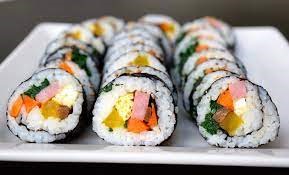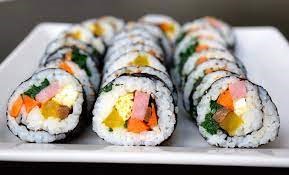Kimbap (김밥), often referred to as “Korean sushi” or “Korean seaweed rice rolls,” is a beloved Korean dish that has captured the hearts and taste buds of people worldwide. This delectable dish, with its combination of fresh ingredients, colorful presentation, and unique flavors, offers a delightful culinary experience. In this comprehensive blog post, we will explore the history, various types, benefits, storage, recipes, ingredients, nutrition, and more about Kimbap (김밥).
The History of Kimbap (김밥)
Kimbap (김밥) may seem like a relatively recent addition to Korean cuisine, but its origins can be traced back to the early 20th century. It was initially inspired by the Japanese dish, “nori-maki,” which consists of rice and ingredients rolled in seaweed. During the Japanese colonial period (1910-1945), this influence on Korean cuisine became more prominent, leading to the creation of Kimbap (김밥).
The name “Kimbap” (김밥) itself holds historical significance. “Kim” (김) refers to the dried seaweed sheets used to wrap the rolls, while “bap” (밥) means rice. Over time, Kimbap (김밥) evolved to incorporate a wide variety of fillings, making it a versatile and popular snack or meal option.

Various Types of Kimbap (김밥)
Kimbap (김밥) comes in a plethora of styles and variations, each with its own unique ingredients and flavors. Here are some popular types of Kimbap (김밥):
- Gimbap (김밥): The classic Kimbap (김밥) is made with rice, vegetables (usually carrots, cucumbers, and pickled radish), eggs, and your choice of protein (common options include beef, ham, or imitation crab meat). It is rolled tightly in a sheet of seaweed and served with a savory dipping sauce.
- Tuna Kimbap (참치김밥): Tuna Kimbap features canned tuna as the primary filling, often mixed with mayonnaise and various vegetables for a creamy and flavorful twist.
- Kimchi Kimbap (김치김밥): For those who love the spicy kick of kimchi, this variation incorporates kimchi along with other vegetables and proteins to create a zesty Kimbap (김밥).
- Samgak Kimbap (삼각김밥): Samgak Kimbap, also known as “triangle Kimbap,” is a portable version of Kimbap (김밥) where the rice and fillings are shaped into triangular rice balls and wrapped in seaweed.
- Yachae Kimbap (야채김밥): Yachae Kimbap focuses on vegetarian ingredients, using a variety of fresh vegetables like spinach, bell peppers, and mushrooms as the main fillings.
- Chamchi Kimbap (참치김밥): Chamchi Kimbap is similar to Tuna Kimbap but features higher-quality tuna cuts for a more refined flavor.
See Also: Sundubu Jjigae (순두부찌개): The Delights Of Korean Cuisine
Benefits of Kimbap (김밥)
Kimbap (김밥) offers a range of benefits, making it a delightful and nutritious choice:
- Balanced Nutrition: Kimbap (김밥) combines carbohydrates from rice, protein from various fillings, and essential vitamins and minerals from vegetables, offering a well-balanced meal.
- Portability: Kimbap (김밥) is easy to pack and carry, making it an ideal choice for picnics, lunchboxes, or on-the-go snacks.
- Customizable: You can personalize your Kimbap (김밥) by choosing your favorite fillings, allowing you to cater to your taste preferences.
- Rich in Fiber: The vegetables in Kimbap (김밥) provide dietary fiber, aiding digestion and promoting a feeling of fullness.
- Low in Saturated Fat: While some variations may include meat or mayonnaise, Kimbap (김밥) can be prepared with lean proteins and minimal added fats, promoting heart health.
How to Store Kimbap (김밥)
Storing Kimbap (김밥) properly is crucial to maintain its freshness and flavor. Here’s how to do it:
- Refrigeration: If you plan to consume Kimbap (김밥) within a day, refrigeration is sufficient. Wrap the Kimbap (김밥) tightly in plastic wrap or aluminum foil to prevent it from drying out.
- Freezing: For longer storage, you can freeze Kimbap (김밥). Wrap individual rolls in plastic wrap and then place them in an airtight container or a freezer bag. Frozen Kimbap (김밥) can last for up to a month.
- Thawing: When ready to eat frozen Kimbap (김밥), let it thaw in the refrigerator for several hours. Reheat it briefly in a pan or microwave for a crispy texture.
Recommended: Popular Italian Dishes
Recipes of Kimbap (김밥)
Making Kimbap (김밥) at home is a rewarding experience. Here’s a simple recipe to get you started:
Ingredients:
- 3 cups cooked sushi rice
- 5 sheets of roasted seaweed (kim)
- 1 carrot, julienned and blanched
- 1 cucumber, julienned
- 1 yellow pickled radish (danmuji), cut into strips
- 2 eggs, beaten and cooked into thin omelets
- 5 slices of ham or your choice of protein
- Sesame oil
- Salt and sugar, for seasoning
Instructions:
- Season the hot rice with sesame oil, salt, and sugar. Allow it to cool to room temperature.
- Lay a bamboo sushi rolling mat (makisu) on a clean surface and cover it with plastic wrap.
- Place a sheet of roasted seaweed (kim) on the plastic wrap-covered mat.
- Wet your hands with water and spread a thin layer of rice evenly over the seaweed, leaving about 1 inch of seaweed at the top edge.
- Add your desired fillings in a row at the bottom edge of the rice.
- Carefully lift the bamboo mat and seaweed, rolling it over the fillings to create a tight cylinder.
- Use a bit of water to moisten the exposed seaweed edge and seal the roll.
- With a sharp knife, slice the Kimbap (김밥) into bite-sized pieces.
- Serve with soy sauce or dipping sauce of your choice.
What to Do with Kimbap
Kimbap is a versatile dish that can be enjoyed in various ways:
- Lunchbox Staple: Kimbap is a popular addition to Korean lunchboxes (doshirak). Its portability makes it an excellent choice for a school or work lunch.
- Picnic Snack: Pack some Kimbap for a picnic in the park. Its convenient size and tastiness make it a great outdoor snack.
- Party Appetizer: Cut Kimbap into bite-sized pieces and serve it as an appetizer at parties or gatherings.
- Healthy Snack: Kimbap can also be a wholesome snack option when you’re craving something savory.
See Also: Haemul Pajeon (해물파전): A Delicious Korean Seafood Pancakes
What to Cook with Kimbap
Kimbap is delicious on its own, but it can also be used as an ingredient in other dishes:
- Kimbap Sushi Bake: Create a delightful casserole by layering Kimbap slices with cream cheese and baking until bubbly and golden brown.
- Kimbap Fried Rice: Dice Kimbap into small pieces and stir-fry them with cooked rice, vegetables, and your choice of protein for a quick and tasty fried rice dish.
- Kimbap Salad: Chop Kimbap into bite-sized pieces and add them to a fresh salad for an extra burst of flavor and texture.
- Kimbap Wraps: Use Kimbap as a filling for lettuce wraps or tortilla rolls for a fusion-inspired meal.
How to Make Kimbap
While we provided a basic recipe earlier, making Kimbap can be a creative process. Here’s a more detailed step-by-step guide:
- Prepare your ingredients: Cook the rice and season it with sesame oil, salt, and sugar. Slice and prepare your choice of fillings (vegetables, protein, and eggs).
- Lay out a bamboo sushi rolling mat (makisu) and cover it with plastic wrap.
- Place a sheet of roasted seaweed (kim) on the plastic wrap-covered mat.
- Wet your hands with water to prevent the rice from sticking, and then spread a thin layer of rice evenly over the seaweed, leaving about 1 inch of seaweed at the top edge.
- Arrange your fillings in a row at the bottom edge of the rice.
- Carefully lift the bamboo mat and seaweed, rolling it over the fillings to create a tight cylinder.
- Use a bit of water to moisten the exposed seaweed edge and seal the roll.
- With a sharp knife, slice the Kimbap into bite-sized pieces.
- Serve with soy sauce or your favorite dipping sauce.
Must Read: A Taste of Korea: Ssambap 쌈밥, Rice Wrap
Kimbap Ingredients
The ingredients for Kimbap can vary widely based on personal preferences, but here are some common components:
- Rice: Sushi rice seasoned with sesame oil, salt, and sugar forms the base of Kimbap.
- Seaweed (Kim): Roasted seaweed sheets are used to wrap the Kimbap.
- Vegetables: Common vegetable fillings include carrots, cucumbers, spinach, and yellow pickled radish (danmuji).
- Protein: Kimbap can include proteins like beef, ham, imitation crab meat, tuna, or even tofu for a vegetarian option.
- Eggs: Thin omelets made from beaten eggs are a traditional filling.
- Sesame Oil: Used for flavoring the rice and seaweed.
- Salt and Sugar: Seasonings for the rice.
Nutrition in Kimbap
Kimbap offers a balanced and nutritious meal option:
- Calories: The calorie content of Kimbap can vary depending on its ingredients and size, but a typical roll contains around 300-400 calories.
- Protein: Kimbap provides protein from sources like eggs, meat, or seafood.
- Carbohydrates: The rice in Kimbap is a good source of carbohydrates, providing energy.
- Fiber: Vegetables in Kimbap contribute to dietary fiber, aiding digestion.
- Vitamins and Minerals: Kimbap contains various vitamins and minerals from the vegetables used as fillings.
- Healthy Fats: Sesame oil used in Kimbap is a source of healthy unsaturated fats.
- Low in Saturated Fat: If prepared with lean proteins and minimal added fats, Kimbap can be a low-saturated-fat option.
See Also: Galbi (갈비): Unveiling the Delightful World Of Korean cuisine
FAQs
1. Is Kimbap the same as sushi?
- While Kimbap and sushi both involve rice and seafood, they differ in several ways. Kimbap uses roasted seaweed, often includes cooked or pickled ingredients, and is seasoned with sesame oil. Sushi typically uses raw fish and vinegared rice, and it is seasoned with rice vinegar, sugar, and salt.
2. Can I make vegetarian Kimbap?
- Absolutely! Yachae Kimbap is a vegetarian variation that uses a variety of fresh vegetables as the main fillings. You can customize it with your favorite vegetables and omit any animal proteins.
3. Are there gluten-free Kimbap options?
- Kimbap can be made gluten-free by using gluten-free soy sauce and ensuring that all ingredients are free from gluten contamination. Rice and vegetables are naturally gluten-free.
4. What is the best dipping sauce for Kimbap?
- Soy sauce mixed with a bit of rice vinegar and a pinch of sugar makes a classic dipping sauce for Kimbap. You can also add some sesame seeds or gochugaru (Korean red pepper flakes) for extra flavor.
5. Can I make Kimbap in advance for a party?
- Yes, you can prepare Kimbap in advance and refrigerate or freeze it. It’s a convenient option for parties and gatherings, as it allows you to focus on other aspects of the event.
Conclusion
Kimbap is not just a delicious Korean dish; it’s a symbol of Korean culinary creativity and innovation. With its rich history, versatility, and nutritional benefits, Kimbap has become a beloved staple in Korean cuisine and has gained international popularity.
Whether you enjoy it as a quick snack, a packed lunch, or a creative ingredient in fusion dishes, Kimbap offers a delightful and satisfying eating experience. So, roll up your sleeves and embark on a Kimbap culinary adventure in your own kitchen, exploring the endless possibilities of this delightful Korean dish.
Recommended: Dishes that can be made using Leftover Food

